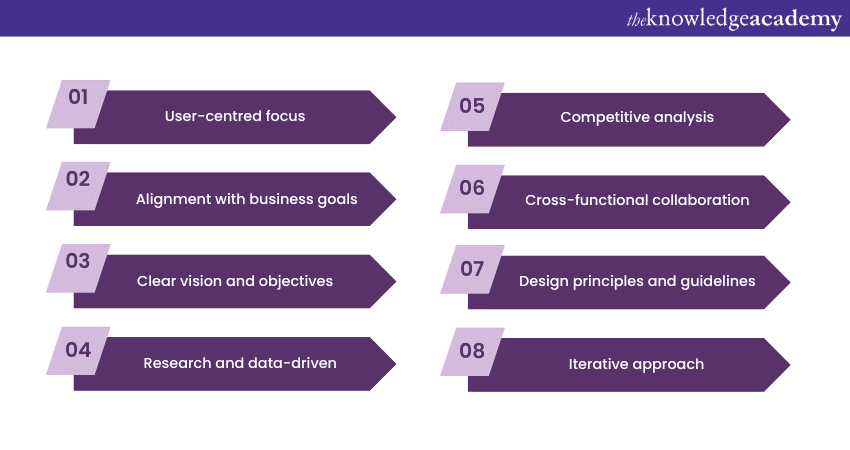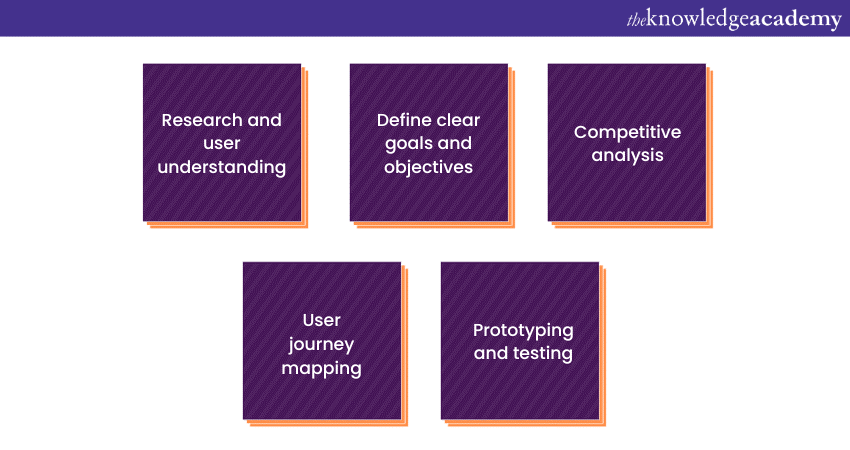We may not have the course you’re looking for. If you enquire or give us a call on +44 1344 203 999 and speak to our training experts, we may still be able to help with your training requirements.
Training Outcomes Within Your Budget!
We ensure quality, budget-alignment, and timely delivery by our expert instructors.

When it comes to a very successful company, what is the first thing that comes up? Solid Marketing or excellent customer service? Or maybe a company's innovative product. Beyond any doubt, when you think about any successfully thriving company, you need to consider all these points. But still, we are forgetting one more thing, which is UX Designs.
Well, it is true that companies used to only ask for help from UX designers at certain times. But now, because top-level executives are realising how good UX design can help their business, more and more companies are hiring UX designers to make sure their customers have great experiences at every step of their journey with the company.
So, UX designers have more responsibilities these days. To make sure they do their job well, they need clear goals and rules for their projects. This is where UX Strategy becomes important. UX Strategy is a set of actions intended to improve the organisation's user experience over a certain period. Learn more about UX Strategy and how to create one by reading this blog on UX Strategy and how this is immensely helpful for the organisations.
Table of Contents
1) Understanding UX Strategy
2) The importance of UX Strategy
3) Features of UX Strategy
4) The UX Strategy framework
5) Tips to create UX Strategy in organisation
6) Examples of Successful UX Strategy
7) Common UX Strategy Challenges and Solutions
8) Conclusion
Understanding UX Strategy
UX Strategy is a systematic approach to enhancing User Experience (UX) by aligning design and business goals. It begins with understanding users through research and personas, setting clear objectives, and analysing competitors. User journey mapping, design principles, and prototyping help shape the UX. Integration into the organisation involves stakeholder buy-in, cross-functional collaboration, and iterative implementation. Success is measured with key performance indicators, user feedback, and continuous optimisation. Real-world examples, challenges, and solutions provide practical insights. In a technology-driven world, UX strategy ensures products and services are user-centric, fostering satisfaction and business growth.
Register for our UX/UI Design Jumpstart Course and take the first step towards crafting exceptional user experiences.

The importance of UX Strategy
The importance of UX (User Experience) strategy cannot be overstated in today's digital landscape. Here are key reasons why it holds such significance.
1) User-centric focus: UX Strategy places users at the forefront of product development. It ensures that every design decision is made with the user's needs, preferences, and pain points in mind, leading to products that resonate with and delight users.
2) Competitive advantage: In a crowded marketplace, offering a superior user experience (UX) can set a company apart. A well-executed UX Strategy can be a powerful differentiator, attracting and retaining customers in a fiercely competitive environment.
3) Increased user satisfaction: A solid UX strategy endeavours to craft products and services that exhibit intuitiveness, user-friendliness, and a delightful user experience. This not only satisfies existing users but also encourages word-of-mouth recommendations and positive reviews, driving organic growth.
4) Higher conversion rates: A seamless and user-friendly experience can lead to higher conversion rates. Whether it's making a purchase, signing up for a service, or any other desired action, a well-thought-out UX Strategy can streamline the process and reduce friction.
5) Cost savings: Investing in UX Strategy upfront can save costs in the long run. By identifying and addressing usability issues early in the design phase, companies can avoid expensive redesigns and reduce customer support costs related to user confusion or frustration.
6) Brand loyalty: Users who have positive experiences with a product or service are more likely to become loyal customers. A strong UX Strategy helps build trust and loyalty, promoting long-term relationships with users.
Features of UX Strategy

A well-defined UX strategy helps ensure that user needs and business goals align. Here are some key features and elements of UX strategy.
1) User-centred focus: UX strategy starts with a deep understanding of the users and their needs. It involves research, user personas, user journeys, and empathy to ensure that design decisions are driven by user requirements.
2) Alignment with business goals: A strong UX strategy aligns user needs with the business's objectives. It should demonstrate how improving the user experience will ultimately benefit the organisation.
3) Clear vision and objectives: A UX strategy should have a clear, concise vision statement that outlines the desired user experience and objectives that need to be achieved to realise that vision.
4) Research and data-driven: Effective UX strategies are based on thorough user research and data analysis. This includes user interviews, surveys, usability testing, and other research methods to inform design decisions.
5) Competitive analysis: Understanding what competitors are doing and how users interact with their products can help inform your UX strategy. Identifying gaps and opportunities in the market is crucial.
6) Cross-functional collaboration: UX strategy often involves collaboration with various departments such as marketing, development, and product management. Cross-functional teams ensure that everyone is aligned with the UX goals.
7) Design principles and guidelines: Establish design principles and guidelines that provide a framework for consistency and coherence in the user interface and interactions. These guidelines help maintain a unified user experience.
8) Iterative approach: UX strategy should embrace an iterative design process. It's essential to continuously gather feedback, test, and refine designs based on user input and evolving business needs.
The UX Strategy Framework

The UX Strategy framework is a structured approach that guides the development and execution of a user experience strategy. It encompasses several key elements and stages to ensure a comprehensive and user-centric approach. Here's a breakdown of the UX Strategy framework.
Research and user understanding
It's essential to start with comprehensive user research to lay the foundation for a successful UX Strategy. This involves diving into user behaviours, needs, and pain points through methods like surveys, interviews, usability testing, and analytics analysis. Additionally, creating user personas, which represent various segments of your target audience, helps in humanising users and guides design decisions.
Define clear goals and objectives
A crucial step in the UX Strategy framework is setting clear and measurable objectives. These objectives should align with both user needs and broader business goals. It's essential to establish a strong connection between UX objectives and key business objectives such as revenue growth, cost reduction, or customer retention.
Competitive analysis
Analysing the competitive landscape is vital to understand where your product or service stands in terms of user experience. Identifying your competition and dissecting their UX strategies, user interfaces, and features can provide valuable insights and reveal opportunities for differentiation.
User journey mapping
Mapping the user journey involves comprehending the various touchpoints and interactions users have with your product or service. It's an opportunity to identify pain points, bottlenecks, and moments of friction in the user experience. This insight is invaluable for streamlining the user journey and improving overall satisfaction.
Design principles
Establishing design principles is about creating a cohesive and user-friendly interface. Consistency in design and usability is crucial for making the user experience intuitive and efficient. Additionally, prioritising accessibility and inclusivity ensures that your product or service is usable by a broader audience.
Prototyping and testing
Once design concepts are developed, the next step is to create interactive prototypes or mock-ups to visualise how the user interface will function. These prototypes are then tested with real users to gather feedback and uncover usability issues. This iterative process helps refine designs based on real-world user input.
Elevate your skills with our UX Masterclass. Register now for a transformative learning experience!
Tips to create UX Strategy in your organisation
Integrating UX Strategy into your organisation is a critical step to ensure that user experience principles are consistently applied across all aspects of your business. Here are some tips to help you successfully implement UX Strategy within your organisation.
1) Executive buy-in and education: Start by securing support from top-level executives and educating them about the value of UX. Executive buy-in ensures the allocation of necessary resources and budget for UX initiatives.
2) Cross-functional collaboration: Foster collaboration between different departments, including marketing, development, and customer support. Encourage teams to work together to maintain a consistent user experience.
3) User-centred design processes: Incorporate user-centred design principles into your organisation's workflows. Promote techniques like user research, usability testing, and iterative design to continuously improve products and services.
4) Clear UX metrics and measurement: Define and track UX-related key performance indicators (KPIs) consistently. Metrics like user satisfaction scores, task success rates, and conversion rates help evaluate the impact of UX improvements.
5) UX guidelines and standards: Develop and maintain comprehensive UX guidelines and standards that provide clear instructions on design principles, accessibility, and usability. Ensure accessibility to all teams and regularly update these guidelines.
6) User feedback and iteration: Create effective channels for collecting user feedback, such as surveys, feedback forms, or customer support channels. Act on this feedback to make informed decisions and prioritise iterative improvements to enhance the user experience.
Examples of successful UX Strategies
Successful UX strategies are integral to creating products and services that users love and can navigate effortlessly. Here are a few examples of companies with effective UX strategies.
1) Google: Google's search engine is a prime example of a user-friendly interface. It provides a minimalist design with a single search bar, emphasising speed and simplicity. Their continuous refinement of search algorithms and the inclusion of features like autocomplete and voice search make it easier for users to find information quickly.
2) Netflix: Netflix's success is rooted in its personalised recommendation system. By analysing user viewing habits and preferences, Netflix suggests content tailored to individual tastes. The intuitive and user-centric interface allows users to seamlessly browse, select, and watch content.
3) Amazon: Amazon's e-commerce platform focuses on user convenience. The one-click ordering, comprehensive product reviews, and hassle-free return policy enhance the overall shopping experience. Their commitment to user feedback and data-driven improvements ensures a continuously evolving and user-friendly platform.
4) Spotify: Spotify's music streaming service provides a user-friendly interface for discovering and enjoying music. Their algorithms create personalised playlists and recommendations based on listening history, while a simple and intuitive design ensures easy navigation.
Common UX Strategy challenges and solutions
Common UX Strategy challenges often arise when implementing user-centred design processes within an organisation. Here are some of these challenges and corresponding solutions.
Challenge 1: Budget constraints
Solution: To address budget limitations, prioritise UX efforts based on their potential impact. Begin with low-cost usability testing and iterative design improvements. Make a compelling case to demonstrate how investing in UX can lead to long-term cost savings by reducing support and development expenses.
Challenge 2: Resistance to change
Solution: Overcoming organisational pushback requires effective communication. Clearly articulate the benefits of UX improvements, emphasising how they align with business goals and can positively impact the bottom line. Engage essential stakeholders in the decision-making process and offer training to assist teams in embracing fresh UX methodologies.
Challenge 3: Keeping up with technology
Solution: Technology evolves rapidly, and staying current can be demanding. Allocate resources for ongoing education and training to keep your UX team up-to-date with the latest tools and design trends. Additionally, conduct regular technology assessments to identify opportunities for integrating new technologies into your UX Strategy.
Challenge 4: Lack of user-centric culture
Solution: Creating a user-centric culture requires ongoing effort. Encourage employees at all levels to empathise with users and consider their needs in decision-making processes. Celebrate and reward teams that prioritise user-centred design and share user success stories throughout the organisation.
Conclusion
This blog has discussed about UX Strategy in detail covering what UX Strategy is, its importance, framework, examples, challenges and solutions. To build unique and user-friendly products, we need to invest a lot of time in planning, research, testing and more. Implementing a carefully structured UX Strategy assists in preventing mishaps and loss of money.
Get started on your Mobile App Development Training today!
Frequently Asked Questions
Upcoming Programming & DevOps Resources Batches & Dates
Date
 UI UX Design Course
UI UX Design Course
Mon 13th Jan 2025
Mon 10th Mar 2025
Mon 19th May 2025
Mon 21st Jul 2025
Mon 15th Sep 2025
Mon 17th Nov 2025
Mon 15th Dec 2025







 Top Rated Course
Top Rated Course


 If you wish to make any changes to your course, please
If you wish to make any changes to your course, please


